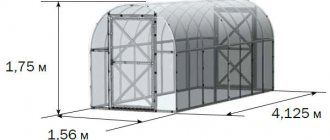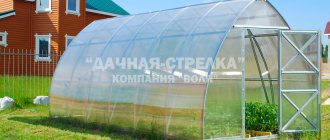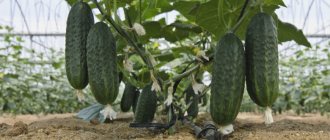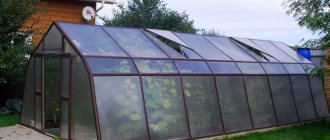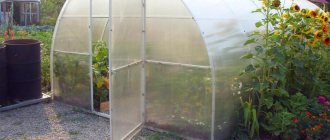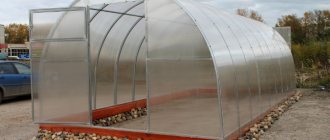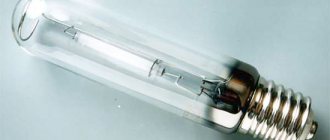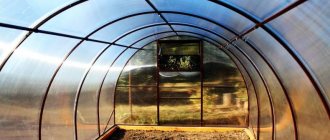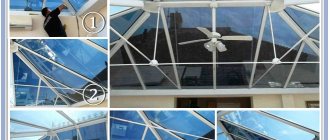A coating of light-transmitting cellular polycarbonate promotes active, uniform growth of crops, protects them from frost and harmful UV radiation and increases yield by 50-300%.
If you are planning or are already growing vegetables, dream of a rich harvest and want to buy an inexpensive polycarbonate greenhouse, we offer our products.
We have been working on the market since 1998; we occupy top positions in the production and sale of greenhouses in the North-West region of the Russian Federation. We have our own powerful production base, which allows us to produce a wide range of products. Currently, the catalog contains more than 500 options for greenhouses and greenhouses.
Features of the range
The polycarbonate structures we offer are highly durable, resistant to mechanical and wind loads, exposure to precipitation and certain types of chemicals.
Greenhouses for summer cottages made of polycarbonate from Greenhouse Choice LLC:
- attract attention with its neat appearance and safety in use - unlike glass, polycarbonate does not form sharp fragments upon impact;
- differ in width, height, design features, design - modifications were developed in such a way that buyers could organize full-fledged beds for growing different types of crops and arrange convenient passages between them;
- have a metal frame made of a metal profile with a square section of 20x20, 25x25, 30x30, 20x40 (you can choose from galvanized or powder-coated profiles made in Russia);
- equipped with polycarbonate, which is optimally suited for equipping a specific greenhouse model (you can choose regular cellular or phyto-polycarbonate with a thickness of 4-6 mm);
- equipped with windows and doors at each end, which provides easy access inside and the ability to ventilate the greenhouse; equipped with fittings - handles, hooks for fixing doors/windows;
- easy to assemble and disassemble even without special skills: self-assembly takes 2-3 hours (specialists complete the work in 50-70 minutes). This speed is possible because the ends are already welded, the holes are drilled, the parts fit perfectly, and the fasteners are part of the standard kit and you just need to assemble the elements into one whole;
- allow an increase in area by installing additional modules (the length of a standard extension is 2 meters) and the ability to move to another location (provided that the length of the greenhouse does not exceed 4 meters).
The structures are installed on the ground or different types of foundation: timber, concrete. Metal reinforcement is used to fix the foundation to the ground.
When disassembled, greenhouses have compact dimensions, which allows them to be transported in minibuses or trailers. Collected greenhouse samples can be seen in our stores.
Important nuances
- For winter crops, it is advisable to use winter-hardy vegetable and green crops, represented by red and green lettuce, chicory, chard, spinach and watercress, the young shoots of which are able to withstand periodic decreases in temperature.
- The key to the success of growing plants in greenhouses in the northern region is to strictly adhere to the sowing time of seed material.
- It should be remembered that the most massive foundation under a greenhouse structure allows heat to be retained inside the structure for a very long time.
Why us?
The main arguments for cooperation with Greenhouse Choice are that we:
- We develop projects taking into account the current needs of gardeners and climate conditions;
- We manufacture garden greenhouses using materials purchased from trusted suppliers and guarantee the quality of the final product;
- We relieve buyers from the need to look for a suitable vehicle with a driver - we offer delivery;
- We carry out installation - our specialists have accumulated extensive experience in the assembly and installation of greenhouses, so they work quickly and efficiently.
The complete set of greenhouses includes a full set of elements - frame and polycarbonate, fastening and fixing of covering material, illustrated step-by-step assembly instructions. This saves you from searching for the necessary parts and makes installation easier and faster.
The online store presents not only finished products, but also individual elements: frames, partitions with doors, vents, as well as related products - ready-made foundations made of timber or its individual parts, extension cords, garden bed fencing, automatic drip irrigation systems, cellular polycarbonate, spunbond
We sell the entire range at real market prices - without intermediary markups and surcharges (after registering on the site in your personal account, you will see personal wholesale prices for hypermarkets and large farms). Such low prices are possible due to our own production and direct contacts with suppliers of consumables.
Upon their first purchase, customers additionally receive a savings card, which allows them to recommend us to their friends and earn bonuses for subsequent purchases.
You can take out the purchased goods yourself or order delivery (within St. Petersburg, up to 130 km from the Ring Road and to some cities in the region - free of charge).
Requirements for structures
The experience of many gardeners has been able to prove that the use of modern technologies and materials makes it possible, even in harsh weather conditions in the far north and in the Arctic, to quite successfully cultivate not only vegetables, but also fruits and berries. One should take into account the fact that the risky farming zone involves more significant costs not only for the construction of a greenhouse structure, but also for its maintenance. In addition, crop production in such unfavorable conditions involves the construction of greenhouses, which must meet the following requirements:
- high level of strength and reliability, allowing the structure to withstand heavy snowfalls and strong winds;
- the ability to replenish the lack of thermal and solar energy for grown plants.
For this purpose, greenhouses with special technical parameters and quality characteristics are used in the northern regions:
- the implementation of the frame of the greenhouse structure involves the use of profile pipes with a rectangular cross-section of at least 4 x 2 centimeters and wall thickness parameters of two millimeters;
- profile arches must withstand at least ninety kilograms of snow load per square meter of the structure;
- using only high-quality polycarbonate sheets with a thickness of at least one centimeter. The optimal thickness of such translucent plastic should be sixteen millimeters.
How to choose and buy a greenhouse for a summer residence
Before purchasing a greenhouse, review the catalog and select the modification that ideally suits your requirements.
Decide on the size
The design is selected depending on the characteristics of the site on which it will be installed, as well as plans for growing seedlings, herbs, and vegetables.
The online store offers different options: from narrow, 1.6 meters wide (designed for arranging 1 bed and 1 passage between them) to wide - 5 m (for 3-4 beds and 2-3 passages).
If desired, the area of the greenhouse can be increased by purchasing an extension module.
Important!
The dimensions of the greenhouses are encoded in the name. There are special designations for width: Micro - 1.6 m, Optima (2.1 m), Mini (2.5 m), Standard (3 m), Maxi (3.5 m), Macro (4 m) and Mega (5 m).
Pay attention to the frame
The profile is chosen depending on whether you have the opportunity to regularly clear the surface of the greenhouse from snow. If such a prospect is not for you, and winter in your region is mostly snowy, you should look for a modification with a powerful profile. These are, for example, greenhouses of the “Manor” or “Spring” series with a profile of 30x30, 20x40 mm, respectively, and an interarc distance of 50 and 65 cm.
Budget greenhouses with a 20x20 profile are suitable for those buyers who can promptly remove snow from the surface or live in areas of the country with little snow. An example of such a design is the Agronomist greenhouse. If a modification with an inter-arch distance of 100 cm is selected for purchase, then winter supports should be installed to increase its strength.
In terms of price-quality ratio, the ideal greenhouses are the “Fazenda” series with a square of 25x25 mm and an interarc distance of 65 cm.
Important!
The type of profile is indicated in the name of the model: Agronom - 20x20 mm, Hacienda - 25x25, Spring - 20x40, Estate - 30x30 mm.
When selecting a frame, the coating of the parts is also taken into account (it, like other technical issues, is reflected in the name of the product). We offer a profile:
- OTs - galvanized;
- GREEN - finished with environmentally friendly green powder paint (domestic compositions are used).
Standard greenhouse frames have 2 ties. They are sufficient for reliable adhesion of the elements - a larger number of holes in the arches reduces the overall load-bearing capacity of the structure. Our product line also includes models with 5 ties. An example is the “Fazenda standard OTs65”, equipped with galvanized tape.
Select the type of coating for the frame
The greenhouses presented in the catalog are equipped with polycarbonate (4-6 mm thick), which is suitable for a specific model. If desired, the buyer can change the type of material according to personal preferences. This is possible, but not advisable because:
- in the production of cheap sheets, the manufacturing technology may not be followed, and they will not withstand the desired loads;
- the use of thin polycarbonate will require an increase in the number of load-bearing frame elements to ensure the necessary strength;
- a thicker panel will not only reduce light transmission, but will also require reinforcement of the frame.
For easy selection, each product item is accompanied by an image, detailed description, technical characteristics, additional options and price tag. If desired, use filters to compare several greenhouse options.
Having decided on the model, click on the appropriate buttons to select the required options - foundation option, free assembly or discount, add the item to the cart and place an order, indicating the need for delivery. You can pay for your purchase by credit card, electronic currency, wire transfer or cash upon receipt.
If the offered assortment makes it difficult for you to choose, please contact one of our stores for advice or contact the manager by phone. He will take into account your wishes and capabilities and select the optimal modification.
Arrangement of winter greenhouses
In order to engage in crop production when nature does not provide for it, the winter greenhouse must maintain the temperature, light and humidity conditions necessary for the crops.
Heating
Even thermos greenhouses with two layers of SP as cladding for year-round operation in regions with temperate and cold climates, first of all, need an effective heating system. Another thing is that a sealed circuit with minimal heat losses will save on energy. With a lot of design options and types of fuel used, the heating itself comes in several types:
- Air - warm air is supplied through air ducts at different levels or heated and maintained directly by a furnace installed in the room itself.
- Contour - a thermal contour is created along the edges, and if necessary, along the middle part, pipes and radiators are used, the boiler can be installed both in the greenhouse and remotely.
- Subsoil - in regions with a mild climate, where severe frosts are rare, a thermos greenhouse will maintain heat with minimal heating. In this case, a water heated floor circuit or electric cables/mats designed for this specific application are laid in the ground.
- Combined - they combine air or contour heating with subsoil heating for growing crops that are demanding in terms of soil temperature.
Ruslan N
Subsoil heating is not suitable for all crops; in my greenhouse I made a hydraulic system (gravity) using coal with the possibility of attaching a subsoil circuit to it (for growing cucumbers), but for other crops a good subsoil heating system is sufficient.
Or for insurance purposes.
Alla Ivanova
The main heating is contour, pipe, the subsoil circuit is deepened by 30 cm so that it is not damaged when processed with a walk-behind tractor. If the soil is loose, it works well. But for me it’s not so important for lettuce - 14⁰C heat in the soil is enough, but other crops need higher temperatures. I have subsurface heating as an insurance policy; there are very frosty winters.
Which energy carrier to use depends on many factors - cost-effectiveness, availability, and the possibility of automating the process.
- Electricity is one of the most expensive energy sources, but with minimal heat loss it can become the basis of the system. Especially if there is a night tariff and a TA (heat accumulator).
- Mains gas is cheaper than electricity and is not inferior to electrical equipment in terms of the possibility of automating the process, but it is not available in all areas.
- Solid fuel boilers - previously the biggest problem was the need for regular loading, today there are long-lasting models, including homemade ones.
DVAL
I heat a winter greenhouse (100 m²), covered with two layers of film, with a distance of 30-40 cm, with a homemade wood-burning boiler. The set temperature (+20⁰С) is maintained automatically. Adding firewood to the boiler lasted for a day when the temperature dropped to 20-25⁰С below zero, and on “warm days” (5-10⁰С below zero) it lasted up to two days or more if the firewood was oak or acacia. The boiler heats the air - a heat generator (without a water jacket). It’s not particularly annoying, just put it on and sleep peacefully (but the signal about the boiler going out or the wood burning is sent into the house). The cost of making the boiler is insignificant, I made it from what was lying around the yard, I spent only on electrodes (10 kg) and on circles for the grinder. I tried IR gas burners - they are ineffective, they require a lot of air, and when the windows are opened frequently, the heat evaporates.
As DVAL notes, you can heat it however you like and with whatever you want, everyone chooses their own option, which they choose as the optimal one in terms of the combination of costs and returns. Here viktor50 prefers the Bubafonya boiler, and although he has a seasonal greenhouse, such experience can be taken into account.
Lighting and Humidity
Winter days are short, especially in the northern regions, so even with the correct orientation of the greenhouse, for full growth, most crops require additional lighting with special lamps that generate the required spectrum. HPS (sodium arc tube lamps) or LED lamps are used. This is one of the most consumable items in winter crop production, especially on a large scale.
Alla Ivanova
Heat is only one of the conditions, the main thing is light, photosynthesis, however. In the same Novosibirsk region in winter you can only do forcing. Or lamps - for 200 m², about 40 pieces of 400 W each, that’s 18 kW/hour and for 12-16 hours a day.
Of course, when we are talking not about two hundred, but about twenty squares for personal use, the costs are much lower, and many are willing to pay for the opportunity to eat fresh herbs all year round.
Thanks to regular watering, additional air humidification in the winter greenhouse is usually not required. And to prevent it from becoming oversaturated, which is also not good for plants, greenhouses are either ventilated through vents installed in the roof, or a forced ventilation system with a recuperator is created. The second option cannot be called budgetary, and in small greenhouses it is practically not in demand. The irrigation itself is organized on the basis of an insulated underground water supply system or through storage tanks or a root system (drip irrigation).
Greenhouses in Siberia (video)
Before using such a greenhouse structure, it is advisable to familiarize yourself with the approximate schedule of work that should be carried out in double greenhouses. In addition, it should be remembered that in conditions of risky farming and in the northern regions, the construction of permanent greenhouse buildings with heating and additional lighting is practically the only economically viable solution.
In order not to lose the material, be sure to save it to your social network VKontakte, Odnoklassniki, Facebook by simply clicking on the button below:
A greenhouse is proposed, including a foundation, frame and roof. The foundation is made with the formation of an air gap between at least two horizons. The walls and roof of the greenhouse are double. A sealed or nearly sealed space has been created between the walls and roofs for forced air exchange during severe cold weather. This design of the greenhouse will reduce heat loss and also prevent the roof from collapsing under the weight of snow. 3 ill.
CLAIM
A greenhouse for the harsh conditions of the Far North, including a foundation, frame and roof, characterized in that the foundation is made to form an air gap between at least two horizons, and the walls and roof of the greenhouse are double, and an airtight space is created between the walls and roofs for forced heat and air exchange during extreme cold.
| IPC classes: | A01G9/24 devices for heating, ventilation, temperature control and irrigation of greenhouses, greenhouses, etc. |
| Authors): | Antufiev Igor Alexandrovich (RU) |
| Patentee(s): | State scientific institution All-Russian Research Institute of Electrification of Agriculture of the Russian Academy of Agricultural Sciences (GNU VIESKh Rosselkhozakademii) (RU), Antufiev Igor Aleksandrovich (RU) |
| Priorities: |
Drawings for RF patent 2526629
The invention relates to agriculture, namely to greenhouses and other types of closed ground, adapted for intensive cultivation of plant products. The invention can be used in areas with harsh climates up to the Far North.
A technical solution is known for increasing the resistance of a structure to cold in order to perform technological operations for growing plants [Patent of the Russian Federation No. 2069944 GREENHOUSE FOR GROWING GREENHOUSE CROPS AND SEEDLINGS, A01G 9/24, 12/10/1996]. In this invention, the greenhouse floor with a cultural layer is separated from the ground surface and fixed at the ends on two wide and high supports covered with heat-insulating material. Between the supports covering the floor there is a shell with the possibility of rotation around its longitudinal axis. From below, the shell is covered with an arched insulated profile - a half-shell, and the floor itself can be made in several tiers. When a greenhouse operates on the ceiling of a heated building, in order to use the heat from it, instead of a half-shell, two insulated panels are installed in the greenhouse to form a pocket open at the bottom.
The disadvantage of this kind of greenhouses is their unsuitability for the Far North. For regions of the Far North, where extreme weather and climatic conditions do not allow the cultivation of plant products in standard technical and technological support modes, it is rational to use special greenhouses designed for the harsh conditions of the North.
Another patent by the same authors [Patent of the Russian Federation No. 2101918 “GREENHOUSE FOR GROWING GREENHOUSE CROPS AND SEEDLINGS,” A01G 9/14, A01G 9/24, 01/20/1998] proposes heating a multi-tiered floor with electric current.
The disadvantage of this invention is the imperfection of thermal protection of the interior of the greenhouse and the high consumption of electricity for heating the floor.
The purpose of the present invention is to create a greenhouse design suitable for use in the harsh conditions of the Far North.
This goal is achieved by creating improved thermal protection of the walls and roof, which is expressed in the creation of a closed air circuit between the external and internal planes of the walls and roof. In such a closed (sealed or almost sealed) space, air circulates or does not circulate. The air gap can be of a reasonable width, which can be easily calculated from the difference between the minimum and maximum temperatures inside and outside the greenhouse and the standard heat transfer coefficients for the area and materials used.
Another improvement to the thermal protection factor is a foundation with two parallel horizons and with an air gap between the two horizons. The lower horizon of the foundation is made of monolithic reinforced concrete, and the upper horizon, on which the greenhouse frame is located, is made of expanded clay concrete, and the air space between the horizons (or tiers) of the foundation is made airtight.
This arrangement of the greenhouse allows the use of modern biotechnologies in harsh climatic conditions and helps reduce the heat loss of the greenhouse several times compared to the prototype and other greenhouses familiar to the middle zone, which is extremely important for the regions of the Far North. The features of the greenhouse roof prevent it from collapsing under the weight of snow.
In addition, in order to reduce heat loss, the entrance and exit from the greenhouse are made as a heat-protective vestibule with a thermal curtain.
That is, in brief terms we have: “A greenhouse for the harsh conditions of the Far North, including a foundation, frame and roof, characterized in that the foundation is made to form an air gap between at least two horizons, and the walls and roof of the greenhouse are double, and a sealed or nearly sealed space has been created between the walls and roofs for forced air exchange during extreme cold.”
Light transmission of coatings is not a prerequisite for the Far North, since during the long northern night the illumination outside the greenhouse is extremely low and insufficient to illuminate the interior of the greenhouse.
Figures 1, 2 and 3 show the main features of greenhouses for the Far North, where figure 1 shows a general view of the greenhouse, figure 2 shows the features of the foundation, and figure 3 shows typical locations of heat-protective vestibules with thermal curtains.
The greenhouse for the Far North has an outer 1 (Fig. 1) and an inner 2 walls, fixed to metal structures 3 in such a way that an air space is created between the walls, in which forced air exchange is carried out during periods of extreme cold.
The greenhouse is made with horizontal 4 and vertical 5 support structures, and a separate support foundation 6 is formed for the vertical support structures. The same support foundations 7 are made for the walls of the greenhouse and metal structures between the walls. The general composite foundation of greenhouse 8 is shown separately in a special drawing.
The inner 9 and outer 10 roofs are attached to the supporting structures of the greenhouse, forming an air enclosed space 11 between them.
The general foundation of the greenhouse (Fig. 2) is composed of at least two horizons, with the upper horizon 12 made of expanded clay concrete, and the lower horizon 13 formed of monolithic reinforced concrete. Both horizons are separated by monolithic vertical walls 14, sealing the space between the foundation horizons. The risers 15 are made to increase the strength of the foundation as a whole.
The entrance and exit from the greenhouse are equipped with vestibules 16 (Fig. 3) with snow protection slopes 17.
The greenhouse is operated as follows.
After the completed greenhouse is put into operation, cultivation devices for intensive crop production are installed inside it, simultaneously launching a system for reducing heat loss and achieving the required temperature inside the greenhouse. For this purpose, forced heat exchange is organized between walls 1 and 2 (Fig. 1), using blowers (not shown) with a device for controlled air heating. The same type of air exchange is organized between the lower 9 and upper 10 roofs, heating the circulating air to the design temperature.
When the necessary microclimatic conditions inside the greenhouse are achieved, the cultivation units are charged with plant seedlings for future cultivation and cultivation begins, subject to the technological parameters of protecting the internal space of the greenhouse from excessive heat loss.
1. Patent of the Russian Federation No. 2069944 GREENHOUSE FOR GROWING GREENHOUSE CROPS AND SEEDLINGS, A01G 9/24, 12/10/1996;
2. Patent of the Russian Federation No. 2101918 “GREENHOUSE FOR GROWING GREENHOUSE CROPS AND SEEDLINGS”, A01G 9/14, A01G 9/24, 01/20/1998.
